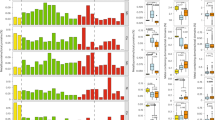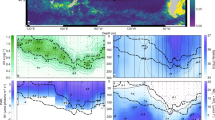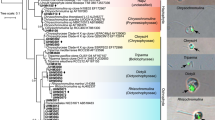Abstract
Phytoplankton is a nineteenth century ecological construct for a biologically diverse group of pelagic photoautotrophs that share common metabolic functions but not evolutionary histories1. In contrast to terrestrial plants, a major schism occurred in the evolution of the eukaryotic phytoplankton that gave rise to two major plastid superfamilies2,3,4. The green superfamily appropriated chlorophyll b, whereas the red superfamily uses chlorophyll c as an accessory photosynthetic pigment5. Fossil evidence suggests that the green superfamily dominated Palaeozoic oceans. However, after the end-Permian extinction, members of the red superfamily rose to ecological prominence. The processes responsible for this shift are obscure. Here we present an analysis of major nutrients and trace elements in 15 species of marine phytoplankton from the two superfamilies. Our results indicate that there are systematic phylogenetic differences in the two plastid types where macronutrient (carbon:nitrogen:phosphorus) stoichiometries primarily reflect ancestral pre-symbiotic host cell phenotypes, but trace element composition reflects differences in the acquired plastids. The compositional differences between the two plastid superfamilies suggest that changes in ocean redox state strongly influenced the evolution and selection of eukaryotic phytoplankton since the Proterozoic era.
This is a preview of subscription content, access via your institution
Access options
Subscribe to this journal
Receive 51 print issues and online access
$199.00 per year
only $3.90 per issue
Buy this article
- Purchase on Springer Link
- Instant access to full article PDF
Prices may be subject to local taxes which are calculated during checkout


Similar content being viewed by others
References
Haeckel, E. Plankton-Studien. Vergleichende Untersuchungen über die Bedeutung und Zusammensetzung der pelagischen Fauna and Flora (G. Fischer, Jena, 1890)
Delwiche, C. F. Tracing the thread of plastid diversity through the tapestry of life. Am. Nat. 154, S164–S177 (1999)
Martin, W. et al. Evolutionary analysis of Arabidopsis, cyanobacterial, and chloroplast genomes reveals plastid phylogeny and thousands of cyanobacterial genes in the nucleus. Proc. Natl Acad. Sci. USA 99, 12246–12251 (2002)
Palmer, J. D. The symbiotic birth and spread of plastids: how many times and howdunit? J. Phycol. 39, 4–11 (2003)
Falkowski, P. G. & Raven, J. A. Aquatic Photosynthesis (Blackwell, Malden, MA, 1997)
Redfield, A. C. in James Johnstone Memorial Volume (ed. Daniel, R. J.) 176–192 (Liverpool Univ. Press, Liverpool, 1934)
Falkowski, P. G. Evolution of the nitrogen cycle and its influence on the biological suquestration of CO2 in the ocean. Nature 387, 272–275 (1997)
Sverdrup, H. U., Johnson, M. W. & Fleming, R. H. The Oceans (Prentice-Hall, New Jersey, 1942)
Sterner, R. W. & Elser, J. J. Ecological Stoichiometry: The Biology of the Elements from Molecules to the Biosphere (Princeton Univ. Press, Princeton, 2002)
Falkowski, P. G. Rationalizing elemental ratios in unicellular algae. J. Phycol. 36, 3–6 (2000)
Geider, R. J. & LaRoche, J. Redfield revisited: variability of C:N:P in marine microalgae and its biochemical basis. Eur. J. Phycol. 37, 1–17 (2002)
Venables, W. N. & Ripley, B. D. Modern Applied Statistics with S-PLUS (Springer, New York, 1999)
Raven, J. A., Evans, M. C. W. & Korb, R. E. The role of trace metals in photosynthetic electron transport in O2-evolving organisms. Photosynth. Res. 60, 111–149 (1999)
Falkowski, P. G., Owens, T. G., Ley, A. C. & Mauzerall, D. C. Effects of growth irradiance levels on the ratio of reaction centers in two species of marine phytoplankton. Plant Physiol. 68, 969–973 (1981)
Price, N. M. & Morel, F. M. M. Cadmium and cobalt substitution for zinc in a marine diatom. Nature 344, 658–660 (1990)
Lee, J. G. & Morel, F. M. M. Replacement of zinc by cadmium in marine phytoplankton. Mar. Ecol. Prog. Ser. 127, 305–309 (1995)
Grzebyk, D., Schofield, O., Vetriani, C. & Falkowski, P. G. The Mesozoic radiation of eukaryotic algae: The portable plastid hypothesis. J. Phycol. 39, 259–267 (2003)
Whitfield, M. Interactions between phytoplankton and trace metals in the ocean. Adv. Mar. Biol. 41, 3–128 (2001)
Williams, R. J. P. & da Silva, J. J. R. F. The Natural Selection of the Chemical Elements (Clarendon, Oxford, 1996)
Andar, A. D. & Knoll, A. H. Proterozoic ocean chemistry and the evolution: A bioinorganic bridge? Science 297, 1137–1142 (2002)
Des Marais, D. J. When did photosynthesis emerge on Earth? Science 289, 1703–1705 (2000)
Falkowski, P. G. et al. in Coccolithophores: Molecular Processes to Global Impact (eds Thierstein, H. & Young, J.) (Springer, Berlin, in the press)
Price, N. M. et al. Preparation and chemistry of the artificial algal culture medium Aquil. Biol. Oceanogr. 6, 443–461 (1988/89)
Ho, T.-Y. et al. The elemental composition of some marine phytoplankton. J. Phycol. (submitted)
Cullen, J. T., Field, T. S. & Sherrell, R. M. The determination of trace elements in filtered suspended marine particulate material by sector field HR-ICP-MS. J. Anal. At. Spectrom. 16, 1307–1312 (2001)
Benjamini, Y. & Hochberg, Y. Controlling the false discovery rate: a practical and powerful approach to multiple testing. J. R. Stat. Soc. B 57, 289–300 (1995)
Ihaka, R. & Gentleman, R. R. Language for data analysis and graphics. J. Comp. Graph. Stat. 5, 299–314 (1996)
Acknowledgements
We thank K. Wyman, C. Fuller, P. Field and R. Sherrell for assisting us with the elemental analysis, and L. Hedin, R. Sherrell and J. Raven for comments. This work was supported by the National Science Foundation ‘Evolution and Radiation of Eukaryotic Phytoplankton Taxa’ (EREUPT) Biocomplexity Program (Rutgers University) and the Centre for Environmental Bioinorganic Chemistry at the Princeton Environmental Institute (Princeton University).
Author information
Authors and Affiliations
Corresponding authors
Ethics declarations
Competing interests
The authors declare that they have no competing financial interests.
Rights and permissions
About this article
Cite this article
Quigg, A., Finkel, Z., Irwin, A. et al. The evolutionary inheritance of elemental stoichiometry in marine phytoplankton. Nature 425, 291–294 (2003). https://doi.org/10.1038/nature01953
Received:
Accepted:
Issue Date:
DOI: https://doi.org/10.1038/nature01953
This article is cited by
-
Trace and rare earth elements in phytoplankton from the Tyrrhenian Sea (Italy)
Environmental Monitoring and Assessment (2024)
-
Changes in nutrient stoichiometry in responding to diatom growth in cyclonic eddies
Geoscience Letters (2023)
-
Rates of seafloor and continental weathering govern Phanerozoic marine phosphate levels
Nature Geoscience (2023)
-
Metals in seston from Cabo Frio Bay, a region under the influence of upwelling in SE–Brazil
BioMetals (2023)
-
Nutrient enrichment favors grazing selectivity and nutritional mismatch in a plankton community
Theoretical Ecology (2023)
Comments
By submitting a comment you agree to abide by our Terms and Community Guidelines. If you find something abusive or that does not comply with our terms or guidelines please flag it as inappropriate.



